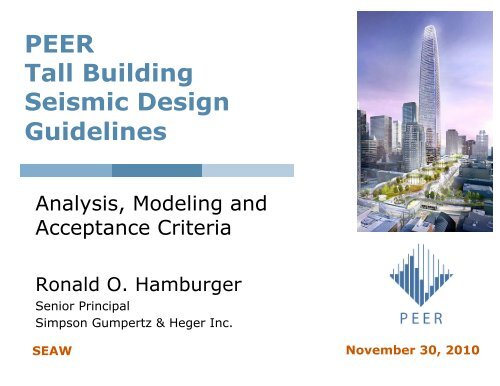PEER Tall Building Seismic Design Guidelines
PEER Tall Building Seismic Design Guidelines
PEER Tall Building Seismic Design Guidelines
You also want an ePaper? Increase the reach of your titles
YUMPU automatically turns print PDFs into web optimized ePapers that Google loves.
<strong>PEER</strong><br />
<strong>Tall</strong> <strong>Building</strong><br />
<strong>Seismic</strong> <strong>Design</strong><br />
<strong>Guidelines</strong><br />
Analysis, Modeling and<br />
Acceptance Criteria<br />
Ronald O. Hamburger<br />
Senior Principal<br />
Simpson Gumpertz & Heger Inc.<br />
SEAW November 30, 2010
Purpose of Analysis<br />
Demonstrate that the design is capable<br />
of acceptable performance<br />
Two performance objectives considered:<br />
Service Level<br />
Maximum Considered Level
Service Level Analysis<br />
Performance Goal:<br />
• Minor structural damage<br />
• Does not compromise structure’s safety<br />
• Repair not required for occupancy<br />
• Repair may be desirable for:<br />
• Appearance<br />
• Durability, moisture and fire resistance
Acceptable Damage<br />
For a limited number of elements:<br />
Minor cracking of concrete<br />
Minor yielding of steel<br />
Unacceptable behavior<br />
Permanent cracks exceeding 1/8”<br />
Spalling of cover or core concrete<br />
Buckling of steel member or rebar<br />
Measurable residual drift<br />
Punching of slab-column joints
Service Level Analysis<br />
Linear response spectrum analysis<br />
(RSA) required<br />
Appropriate to response anticipated at this<br />
performance level<br />
Provides benchmark for later analyses using<br />
nonlinear models<br />
Nonlinear response history analysis can<br />
be run as a supplement, to demonstrate<br />
acceptability when RSA does not so<br />
indicate
What should be modeled?<br />
Intended lateral<br />
system<br />
From base to<br />
penthouse<br />
Any element that<br />
effects stiffness or<br />
can be damaged<br />
by response<br />
Gravity columns<br />
Slabs<br />
Gravity beams<br />
Basement walls
Soil-Structure-Foundation Interaction<br />
Need not be considered<br />
But-<br />
Model must extend to soil-structure interface<br />
Typically top of mat<br />
Include basement walls and slabs<br />
Include mass of basement levels
Torsion<br />
Inherent (natural)<br />
torsion must be<br />
modeled<br />
Accidental torsion<br />
neglected
Element Stiffness<br />
Models must include reasonable<br />
representation of stiffness
Element Stiffness<br />
Beam-column joints<br />
Explicit modeling of stiffness, or<br />
No rigid end offsets for beams
Element Stiffness<br />
Diaphragms<br />
Use realistic assessments of stiffness<br />
Transfer diaphragms must be explicitly<br />
modeled
Load Combinations & Acceptance<br />
RSA<br />
Y<br />
X<br />
Story Drift < 0.005h<br />
C n = nominal capacity (per code)<br />
φ = resistance factor per ACI or AISC
Nonlinear Analysis<br />
Use best estimates of stiffness and<br />
strength
Load Combinations & Acceptance<br />
NLRH<br />
Y<br />
X<br />
Story Drift < 0.005h<br />
Use minimum of 3<br />
pairs of ground<br />
motions<br />
Demand based on<br />
max values from<br />
suite unless 7 or<br />
more pairs of<br />
motions used
Nonlinear Analysis<br />
Nonlinear behavior limited to<br />
deformation-controlled (ductile) actions<br />
Deformations shall be within range that does<br />
not require repair to restore system<br />
strength, as demonstrated by laboratory<br />
testing<br />
Repair, if required, shall not include:<br />
Removal or replacement of concrete other than<br />
cover concrete<br />
Removal or replacement of reinforcing or structural<br />
steel<br />
ASCE 41 Immediate Occupancy values may<br />
be used<br />
Force-controlled (brittle) actions shall not<br />
exceed the expected strengths
Maximum Considered<br />
Level Analysis<br />
Performance Goal:<br />
• Minor implicit risk of collapse<br />
• Modest residual drift<br />
• Limited potential for failure of cladding
Pragmatically<br />
Confirm that:<br />
Inelastic behavior occurs in favorable modes,<br />
envisaged by the design<br />
Excessive force and deformation demands do<br />
not result in undesirable behavioral modes<br />
Transient drifts remain within reliable range<br />
of model and analysis validity<br />
Residual drifts are not excessive<br />
Cladding is capable of sustaining anticipated<br />
drifts
Maximum Considered Level<br />
3-D nonlinear response history analysis<br />
Ground motion input at structure base<br />
SSI Permitted – but not required<br />
Desired Typical<br />
Optional
Behavior Modeling<br />
If structural response approaches<br />
collapse levels, model must capture:<br />
Monotonic behavior at deformation levels<br />
beyond peak (capping) strength<br />
Hysteretic properties characterizing<br />
component behavior:<br />
With cyclic degradation<br />
Without cyclic degradation
Cyclic Degradation
Cylic Degradation<br />
1. Explicit incorporation<br />
2. Cyclic envelope<br />
3. Factored monotonic<br />
4. Monotonic
Explicit Modeling of Degradation<br />
No limitations on use
Cyclic Envelope<br />
Deformations cannot exceed the<br />
backbone envelope established by test
Modified Monotonic
Monotonic<br />
Max deformation limited to deformation<br />
at 0.8F u-mono
Analysis References<br />
ATC-72<br />
NIST Tech Brief
Maximum Considered Level<br />
Acceptance Criteria<br />
Deformation controlled – behavior modes<br />
associated with slow deterioration<br />
Force controlled – rapid deterioration<br />
Elements the failure of which could result in partial<br />
or total collapse<br />
Elements the failure of which have minor<br />
consequences<br />
Story strength loss<br />
Peak transient drift<br />
Residual drift
Deformation Controlled Elements<br />
No criteria other than deformation<br />
demand in any analysis can not exceed<br />
valid range of modeling or δ u .
Force-controlled elements<br />
φ = 1 for inconsequential failures<br />
φ = applicable resistance factor from<br />
material standards otherwise
Story strength loss<br />
Deformation imposed on any story<br />
should not result in story shear strength<br />
loss of more than 20%
Transient and residual drift<br />
Transient story drift<br />
Mean of 7 runs < 0.03<br />
Maximum of any run < 0.045<br />
Residual story drift<br />
Mean of 7 runs < 0.01<br />
Maximum of any run < 0.015

















